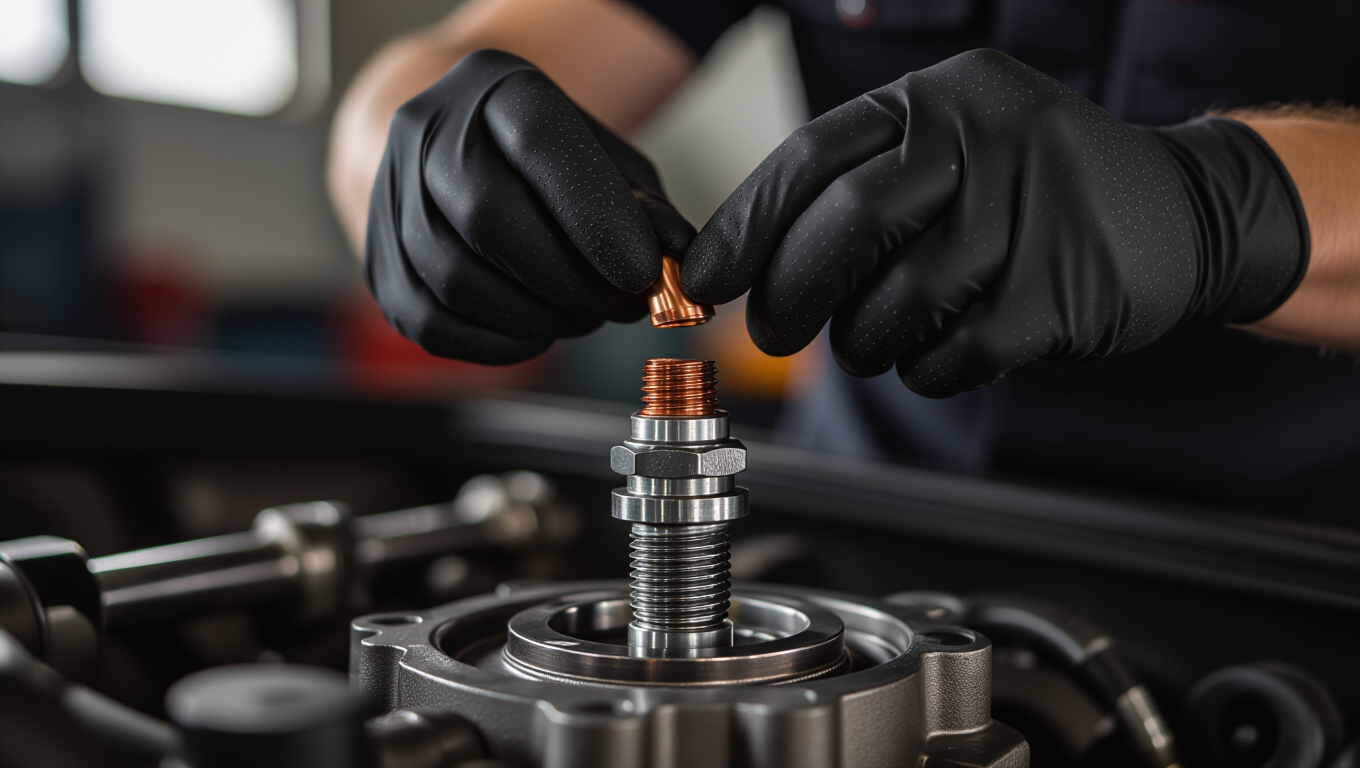You should apply anti-seize on spark plug threads primarily when installing into aluminum cylinder heads or if corrosion and thread galling are concerns. Use a thin, even layer and reduce torque by 20-30% from the manufacturer’s dry specifications to avoid thread damage or over-tightening. Modern plugs with plated threads often don’t need it, as factory torque specs assume dry threads. To understand when and how anti-seize benefits your engine, keep exploring these guidelines.
Key Takeaways
- Anti-seize helps prevent thread galling and makes spark plug removal easier in aluminum cylinder heads.
- Most modern spark plugs have plated threads and usually do not require anti-seize.
- Applying anti-seize requires reducing torque by 20-30% to avoid over-tightening and damage.
- Manufacturer guidelines often recommend dry installation to ensure proper torque and sealing.
- Use anti-seize only when engine design or maintenance conditions justify its benefits.
When to Use Anti-Seize on Spark Plugs

When should you apply anti-seize on spark plugs, and is it necessary? Anti-seize acts as a lubricant on spark plug threads, reducing friction during installation. This means if you use it, you’ll need to reduce the torque by about 20-30% from the manufacturer’s dry torque specifications to avoid over-tightening.
Over-tightening can strip threads, break the plug, or distort the spark plug shell, which may cause leaks and allow blow-by gases to bypass the gasket seal, degrading engine performance.
Many manufacturers like NGK install their spark plugs dry, without any anti-seize, because modern spark plugs often come with plated threads that resist corrosion on their own. Factory torque recommendations generally assume dry threads, so applying anti-seize without adjusting torque can lead to excessive clamping force and damage.
In fact, improper use of anti-seize is a common cause of spark plug breakage during installation or removal. Most spark plug manufacturers advise against applying anti-seize during installation to maintain proper function. Modern engine designs and materials often reduce the necessity for additional lubricants on threads, reflecting advances in engine maintenance.
However, anti-seize does have its place, especially in engines with aluminum cylinder heads, which are more prone to galling and thread seizure. When spark plugs remain in place for many years or are difficult to remove, anti-seize helps prevent the plugs from freezing into the threads, facilitating easier removal and reducing the risk of thread damage.
Using a copper or nickel-based anti-seize ensures electrical conductivity is maintained in the high-voltage environment of the spark plug, which is critical for proper function.
If you decide to use anti-seize, apply a thin, even layer only on the spark plug threads, being careful to keep the ceramic insulator and electrode free of lubricant to avoid fouling. Make sure to use a high-quality, conductive anti-seize formulated specifically for spark plugs. Always reduce the torque by 20-30% from the dry torque value recommended by the manufacturer to prevent over-tightening and potential engine damage.
In many cases, however, especially with modern plated spark plugs and regular maintenance schedules, anti-seize is unnecessary and can complicate installation. It may add unnecessary cost and risk, particularly if you don’t adjust torque properly. Dry installation remains the standard recommended practice by many manufacturers, minimizing issues and ensuring proper clamping force.
Ultimately, whether to apply anti-seize depends on your engine design and maintenance habits. If you have aluminum heads or expect your plugs to stay in place for an extended period, it’s a practical precaution. Otherwise, sticking to manufacturer guidelines and dry installation is usually the best approach.
Frequently Asked Questions
Can Anti-Seize Affect Spark Plug Torque Accuracy?
Yes, anti-seize can affect spark plug torque accuracy because it lubricates the threads, reducing friction. This causes you to over-tighten if you use standard torque specs, risking thread damage or improper sealing.
To maintain correct clamping force, you need to reduce torque by about 20–30%, especially on aluminum heads. Always apply a thin layer and use a precise torque wrench calibrated for the adjusted specification to avoid mechanical issues.
Is Anti-Seize Safe for Use on Platinum Spark Plugs?
You should generally avoid using anti-seize on platinum spark plugs because they come with a special nickel or trivalent plating that acts as an anti-seize layer.
Applying extra anti-seize can cause torque inaccuracies, leading to over-tightening and potential thread damage.
If you do use it, reduce torque by about 20% and avoid contact near the firing tip to prevent electrical interference.
Following manufacturer guidelines keeps installation safe and reliable.
How Often Should Spark Plugs Be Replaced When Using Anti-Seize?
Think of spark plugs like the heartbeat of your engine, needing regular attention regardless of anti-seize use.
You should replace them based on your vehicle or spark plug manufacturer’s recommended intervals—usually between 35,000 and 100,000 miles.
Anti-seize eases removal but doesn’t extend their lifespan.
Stick to specified mileage or timeframes, inspect gaps and wear regularly, and never let anti-seize dictate your replacement schedule.
Does Anti-Seize Impact Spark Plug Heat Range?
Yes, anti-seize affects spark plug heat range by inhibiting heat transfer from the plug to the cylinder head. When you apply anti-seize, it creates a thermal barrier that causes the plug to run hotter than designed, mimicking a higher heat range.
This disrupts proper heat dissipation, risking pre-ignition and fouling. Even small amounts can alter thermal behavior, so you need to contemplate this impact carefully when installing plugs.
Can Anti-Seize Cause Misfires or Ignition Problems?
Yes, anti-seize can cause misfires and ignition problems if it contaminates the spark plug’s core nose or firing tip. Its metallic ingredients may conduct electricity, disrupting spark delivery.
This contamination impairs combustion efficiency, leading to misfires. Additionally, anti-seize affects torque application, risking overtightening and mechanical damage, which indirectly impacts ignition.
To guarantee reliable spark performance, avoid applying anti-seize on spark plugs and follow manufacturer torque specifications precisely.
Spark Plug Success: Precision Over Habit
Think of anti-seize on spark plugs like the secret ingredient in a classic recipe—sometimes essential, sometimes not. You should only apply it when your plugs have a non-coated thread or when you’re working with aluminum heads prone to galling. Overdoing it risks inaccurate torque readings and potential engine issues. So, be precise: use anti-seize sparingly and only when the situation calls for it, ensuring easy maintenance without compromising performance.




